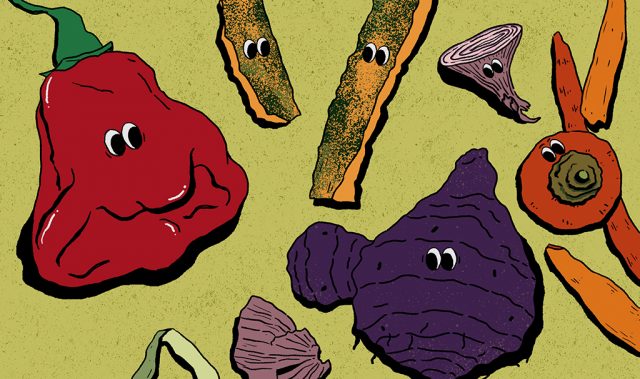
AsianScientist (Nov. 7, 2018) – Some people eat to live, while others live to eat. On one hand, people are enjoying their food too much, to the extent that diet-related conditions such as diabetes and obesity are becoming increasingly common. At the same time, the amount of food waste generated has increased substantially over the years. For example, in Singapore, food waste has increased by 40 percent over the last decade, and in 2017, a total of 809,800 tonnes of food was generated.
As society becomes more health conscious and increasingly aware of environmental sustainability, issues such as the nutritional properties of food items and the recycling of food waste are coming under greater scrutiny. Acknowledging this shift in the consumer mindset, a new breed of food companies is spawning, bringing technology to bear in tackling food-related problems. At TechInnovation 2018, a plethora of food innovations were on display, promising to revolutionise the way we think about food.
Cut the calorie count
Many epicureans will attest to the positive relationship that exists between the number of calories and the superior taste of a food item. Tweaking a recipe could result in a lower calorie count, but the taste and texture of the product may be compromised.
“Even if something novel and healthy, if it doesn’t taste good, would you buy it? Would you want to eat it? That’s the challenge for us,” said Ow Yau Png, Co-Founder and CEO of Hoow Foods Pte Ltd.
With his company’s REGENESYS™ platform, he is able to re-engineer what he calls “indulgent foods” such as ice cream into healthier alternatives that look and taste as good as the original.
“We first develop a target product profile, which specifies the characteristics of the desired food product. Then we analyse the nutritional properties of the ingredient list and identify culprits that contribute to a high calorie count,” he said. The next step involves swapping out ingredients with safe and healthier substitutes using intelligent sourcing and food science. “Finally, we design experiments and iterate the product, getting feedback on the taste, mouthfeel, smell, sweetness and so on,” he added.
The concept of healthier substitute ingredients resonated with Barnabas Chan, Managing Director at BOUNTIFOOD, whose platform technologies such as microencapsulation and nanotechnology can be used to create said substitutes. A proponent of open innovation, Chan explained that while BOUNTIFOOD has in-house food scientists, it also works with chefs and academic researchers to develop novel ingredients. One such product is CarboLight, which was a technology in-licensed from the National University of Singapore.
“CarboLight lowers starch digestibility, thereby slowing down sugar release and prolonging the feeling of fullness,” he said, adding that the product also allows the creation of wholemeal bread with the texture of white bread.
Hence, such ‘upgraded’ ingredients bring together the best of both worlds—healthy food with good taste and texture.
Waste not, want not
The by-products and organic waste generated in the process of creating food items are often an afterthought. But increasingly, food technology companies have come to recognise food waste as a resource rather than a rejected output.
For example, KosmodeHealth has developed a method that can extract soluble fibre and proteins from food processing by-products such as spent grains from the production of tofu, coffee or ethanol.
“The extracted plant proteins provide an economical and alternative source of natural proteins which can be used for the development of supplements or functional food as well as the formulation of our plant-based bio-ink composites for 3D bioprinting,” said Florence Leong, Co-Founder of KosmodeHealth.
Leong highlighted that current printing methods of bioscaffolds for biomedical research involve either synthetic polymers, which living cells do not take well to, or animal collagen which is very expensive.
“As different tissues require bioscaffolds with different properties for cell growth, KosmodeHealth can provide this unique customised 3D bioprinting service. In addition, the bioscaffold enables real-time in vivo monitoring of the biodegradation profile and controlled release of therapeutic compounds during the biodegradation process,” she said.
Also in the business of turning food waste into valuable products is Leo Wein, Managing Director of PROTENGA, an agri-tech company focused on insect-based nutrition, based in Singapore and Malaysia.
“The key to our operations is the black soldier fly,” said Wein, explaining that the larvae are fed pre-consumer food wastes.
These larvae grow rapidly and are protein-rich—ideal feed for livestock such as fish and chicken. The leftovers of the larvae can also be used as organic fertiliser for crops.
“Our global food system depletes resources from nature at unsustainable rates. With our approach, we can reduce the reliance on global resources by upcycling local, low-value protein biomass into high-quality animal protein in the most environmentally responsible way,” said Wein.
In this manner, food waste ends up supporting new food chains, completing the cycle of food production and paving the way for a more sustainable society.
Asian Scientist Magazine is a content partner of IPI.
———
Copyright: IPI. Read the original article here. Photo: Shutterstock.
Disclaimer: This article does not necessarily reflect the views of AsianScientist or its staff.












